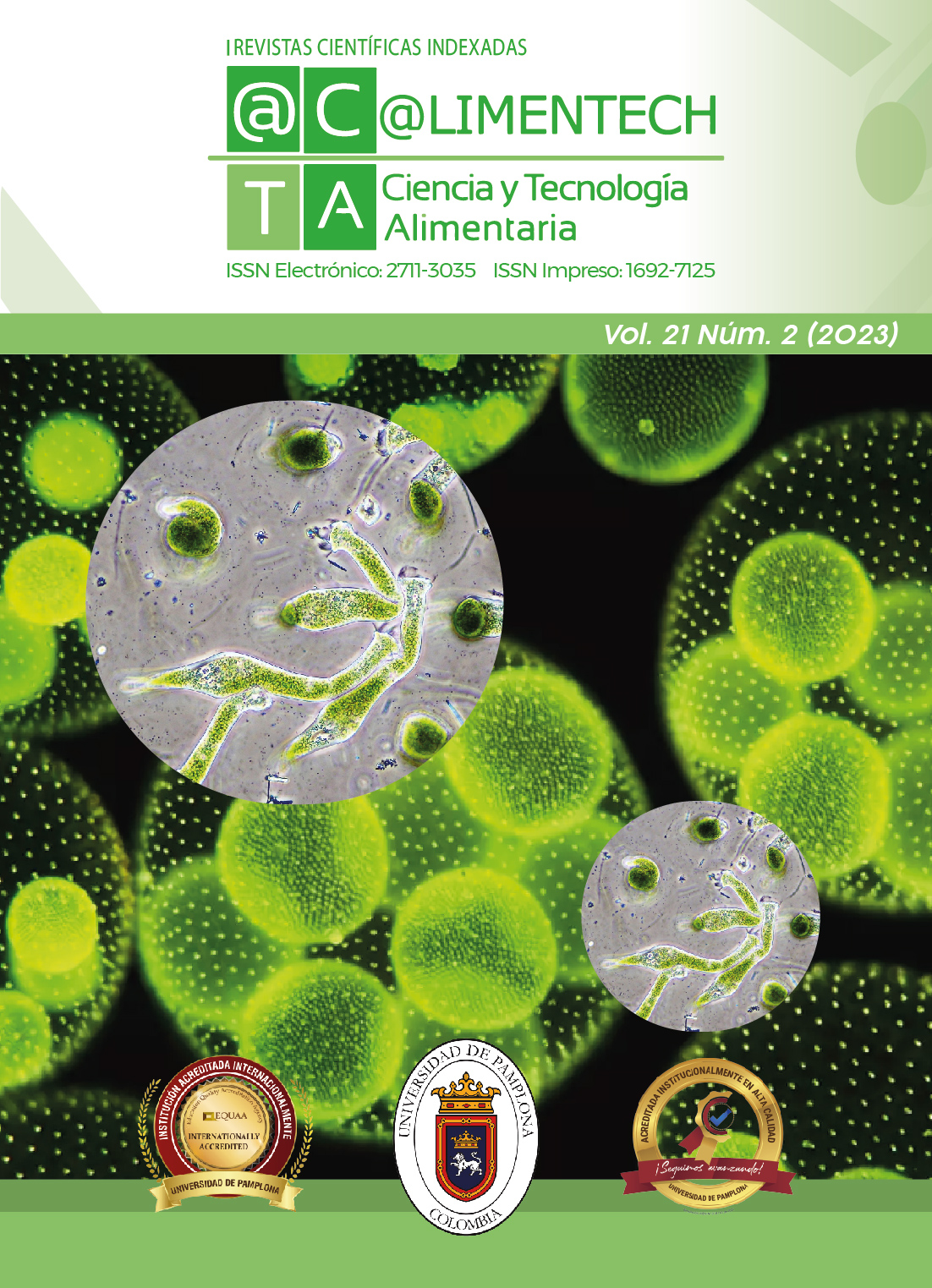Modelo predicitivo de crecimiento de Staphylococcus aureus en queso costeño recubciero con film acido que contiene extracto acuoso de Griricidia sepium
DOI:
https://doi.org/10.24054/limentech.v21i2.2606Palabras clave:
película activa, queso, modelo secundario, extracto acuoso, microbiología predictivaResumen
The effect of thermosonication at three temperatures on the growth of spoilage bacteria in Costeño cheese was investigated. Bacterial counts were fitted to primary models such as Gompertz, Huang, and Buchanan. Polynomial equations were used to describe the effect of thermosonication on the specific growth rate. The mean square error (MSE), bias factor (Bf), and accuracy factor (Af) were used to evaluate the performance of predictive models. The most severe treatment applied in this study was thermosonicated at 40 kHz at 60°C, which led to an increased latency phase and a decreased specific growth rate of the spoilage bacteria analyzed. The specific growth rate values obtained from the Gompertz and Buchanan models were employed to construct polynomial equations. These secondary models had bias factors and accuracy factors close to one, indicating that the polynomial models were able to describe microbial growth in cheese. These results could likely contribute to initiating the application of thermosonication to extend the shelf-life of Costeño cheese
Descargas
Citas
Alonso D., E. von Son-de Fernex, B. Valles-de la Mora, P. Mendoza-de Gives, G. Castillo, A. Zamilpa, & C. González. (2018). Effect of Gliricidia sepium leaves intake on larval establishment of Cooperia punctata in calves and bio-guided fractionation of bioactive molecules. Veterinary Parasitology, 252, 137-14. https://doi.org/10.1016/j.vetpar.2018.02.028
Azadbakht E., Y, Maghsoudlou, M. Khomiri, & M. Kashiri. (2018). Development and structural characterization of chitosan films containing Eucalyptus globulus essential oil: Potential as an antimicrobial carrier for packaging of sliced sausage. Food Packaging and Shelf Life, 17, 65-72. https://doi.org/10.1016/j.fpsl.2018.06.002
Baranyi J., T. Ross, T.A. McMeekin, & A.T. Roberts. (1996). Effects of parameterization on the performance of empirical models used in “predictive microbiology”. Food Microbiol, 13, 83-91. https://doi.org/10.1006/fmic.1996.0010
Baranyi J., C. Pin, & T. Ross. (1999). Validating and comparing predictive models. International Journal Food Microbiology, 48, 159-166. https://doi.org/10.1016/S0168-1605(99)00020-2
Choi W.S., N. Son, J.I. Cho, I.S. Joo, J.A. Han, H.S. Kwak, & S.H. Suh. (2019). Predictive model of Staphylococcus aureus growth on egg products. Food Science and Biotechnology, 28, 913-922. https://doi.org/10.1007/s10068-019-00656-4
Geitenes S., M. Oliveira, D.L. Kalschne, & C.M. Sarmento. (2013). Modelagem do crescimento de bactérias láticas e análise microbiológica em apresuntado e presunto cozido fatiados e embalados à vácuo. Revista Ciências Exatas e Naturais, 15, 113-133.
Gorrasi G., V. Bugatti, L. Tammaro, L. Vertuccio, G. Vigliotta, & V. Vittoria. (2016). Active coating for storage of Mozzarella cheese packaged under thermal abuse. Food Control, 64, 10-16. https://doi.org/10.1016/j.foodcont.2015.12.041
Kim Y.H., G.W. Nam, & K.S. Yoon. (2018). Growth and survival of Staphylococcus aureus on beef jerky as a function of temperature. Journal of Food Safety, 38, e12495.
Lin, L., Hu, J. Y., Wu, Y., Chen, M., Ou, J., & Ling, W. (2018). Assessment of the inhibitory effects of sodium nitrite, nisin, potassium sorbate, and sodium lactate on Staphylococcus aureus growth and staphylococcal enterotoxin A production in cooked pork sausage using a predictive growth model. Food Science and Human Wellnes, 7, 83–90. https://doi.org/10.1016/j.fshw.2018.05.002
Lu, H., Sheen, J., Ping, H., Hui, K., Lung, C., Hwang, C., Sheen, S., Huang, L., & Yan, S. I. (2020). Effect of temperature on the growth of Staphylococcus aureus in ready-to-eat cooked rice with pork floss. Food Microbiology, 89, 103374. https://doi.org/10.1016/j.fm.2020.103374
Mgbeahuruike, E., Yrjönen, T., Vuorela, H., & Holm, Y. (2017). Bioactive compounds from medicinal plants: Focus on Piper species. South African Journal of Botany, 112, 54–69. https://doi.org/10.1016/j.sajb.2017.05.002
Ross, T. (1999). Predictive food microbiology models in the meat industry. Meat and Livestock Australia.
Skandamis, P. N., & Jeanson, S. (2015). Colonial vs. planktonic type of growth: mathematical modelling of microbial dynamics on surfaces and in liquid, semiliquid and solid foods. Frontiers in Microbiology, 6, 1178. https://doi.org/10.3389/fmicb.2015.01178
Swinnen, I. A., Bernaerts, K., Dens, E. J., Geeraerd, A., & Van Impe, J. F. (2004). Predictive modelling of the microbial lag phase: a review. International Journal of Food Microbiology, 94(2), 137–159. https://doi.org/10.1016/j.ijfoodmicro.2004.01.006
Tajkarimi, M., Ibrahim, S. A., & Cliver, D. (2010). Antimicrobial herb and spice compounds in food. Food Control, 21(9), 1199–1218. https://doi.org/10.1016/j.foodcont.2010.02.003
Valdramidis, V. P., & Koutsoumanis, K. P. (2016). Challenges and perspectives of advanced technologies in processing, distribution and storage for improving food safety. Current Opinion in Food Science, 12, 63–69. https://doi.org/10.1016/j.cofs.2016.07.007
Wallin-Carlquist, N., Marta, D., Borch, E., & Radstrom, P. (2010). Prolonged expression and production of Staphylococcus aureus enterotoxin A in processed pork meat. International Journal of Food Microbiology, 141(Suppl. 1), S69–S74. https://doi.org/10.1016/j.ijfoodmicro.2010.02.016
Yu, H., Song, Y., Kim, Y. M., Lee, H., Choi, Y., Lee, N., & Paik, H. (2020). Predictive model of growth kinetics for Staphylococcus aureus in raw beef under various packaging systems. Meat Science, 165, 108108.
Descargas
Publicado
Versiones
- 2023-11-23 (6)
- 2023-11-23 (5)
- 2023-11-23 (4)
- 2023-11-23 (3)
- 2023-11-23 (2)
- 2023-11-23 (1)





